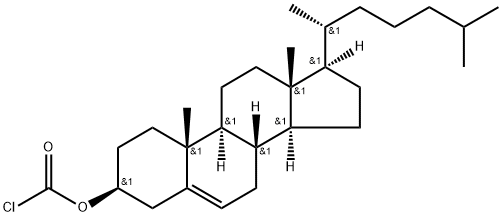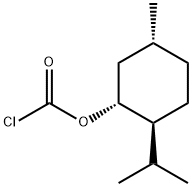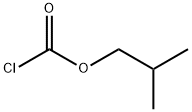Propyl chloroformate
- CAS NO.:109-61-5
- Empirical Formula: C4H7ClO2
- Molecular Weight: 122.55
- MDL number: MFCD00000649
- EINECS: 203-687-7
- SAFETY DATA SHEET (SDS)
- Update Date: 2024-12-18 14:15:32

What is Propyl chloroformate?
Chemical properties
Propyl Chloroformate (PCF) is a colorless to yellow liquid, with a pungent odor. It reacts with water and spontaneous decomposes. It is miscible with benzene and ether.
The Uses of Propyl chloroformate
Propyl Chloroformate is used as a dramatizing agent for the determination of morphine, codeine and 6-acetyl morphine in urine and blood using direct aqueous derivatization.
Production Methods
Prepared by the reaction of liquid anhydrous n-propyl alcohol with molar excess of dry, chlorine-free phosgene at low temperature.
What are the applications of Application
Propyl chloroformate has been used:
as derivatization reagent in quantification of dopamine, serotonin and norepinephrine in human urine by solid phase microextraction-gas chromatography-triple quadrupole mass spectrometry
in the preparation of dipropyl 3,6-diphenyl-1,2-dihydro-1,2,4,5-tetrazine-1,2-dicarboxylate
N-propyl chloroformate is an intermediate of the fungicide propamocarb.
Preparation
Synthesis of Propyl chloroformate: Add n-propanol to the phosgene-passing kettle, start stirring, and then pass phosgene through the phosgene flowmeter. The phosgene-passing temperature is about 30 °C, and continue to pass the phosgene for several hours. When the end point is approached, sample and analyze, and stop when the standard is reached. Pass phosgene, cool, and then pass nitrogen to drive away phosgene and hydrogen chloride, destroy phosgene, and sample and analyze it as a product.
Reaction equation: CH3CH2CH2OH+COCl2→ClCOOCH2CH2CH3
General Description
N-propyl chloroformate appears as a colorless liquid. May be decomposed by water. Severely irritates skin and eyes. Very toxic by ingestion, inhalation or skin absorption. Denser than water and vapors heavier than air. Flash point 50°F. Used to make other chemicals.
Air & Water Reactions
Highly flammable. Water (moisture in air or soil) reacts with generation of heat and hydrochloric acid.
Reactivity Profile
Unstable, decomposes spontaneously to form hydrochloric acid and other products. Avoid moist air. [EPA, 1998]. May react vigorously or explosively if mixed with diisopropyl ether or other ethers in the presence of trace amounts of metal salts [J. Haz. Mat., 1981, 4, 291].
Health Hazard
Strongly irritating to eyes and mucous membranes. Poisonous; may be fatal if inhaled, swallowed or absorbed through skin.
Fire Hazard
When heated to decomposition, Propyl chloroformate emits toxic fumes of chlorine containing compounds. Propyl chloroformate is a flammable/combustible material; Propyl chloroformate may be ignited by heat, sparks or flames. Vapors may travel to a source of ignition and flash back. Container may explode in heat or fire. Vapor explosion and poison hazard indoors, outdoors or in sewers. Runoff to sewer may create fire or explosion hazard. Runoff from fire control or dilution water may cause pollution. Gradually decomposed by water and alcohol. Unstable, decomposes spontaneously to form hydrochloric acid and other products. Avoid moist air.
Flammability and Explosibility
Flammable
Safety Profile
Poison by skin contact. Moderately toxic by ingestion and inhalation. A corrosive irritant to skin, eyes, and mucous membranes. Flammable when exposed to heat or flame, can react vigorously with oxidizing materials. When heated to decomposition it emits toxic fumes of Cl-. Used as a reactive intermediate to polymerization initiators.
Potential Exposure
Propyl chloroformate is used in organic synthesis; as an intermediate for polymerization initiators; may have been used as a military poison gas.
Shipping
UN2740 n-Propyl chloroformate, Hazard class: 6.1; Labels: 6.1-Poison Inhalation Hazard, 3-Flammable liquid, 8-Corrosive material. Inhalation Hazard Zone B
Incompatibilities
Propyl chloroformate forms explosive mixture with air. Incompatible with oxidizers (chlorates, nitrates, peroxides, permanganates, perchlorates, chlorine, bromine, fluorine, etc.); contact may cause fires or explo- sions. Keep away from alkaline materials, strong bases, strong acids, oxoacids, epoxides, water and alcohols. Reaction with water forms heat and hydrochloric acid. Attacks some metals and coating in the presence of moisture.
Properties of Propyl chloroformate
| Boiling point: | 105-106 °C(lit.) |
| Density | 1.09 g/mL at 25 °C(lit.) |
| vapor pressure | 0.87 psi ( 20 °C) |
| refractive index | n |
| Flash point: | 84 °F |
| storage temp. | 2-8°C |
| solubility | benzene: miscible(lit.) |
| form | Oil |
| color | Colourless |
| Specific Gravity | 1.09 |
| Merck | 13,7940 |
| Dielectric constant | 11.2(20℃) |
| Stability: | Volatile |
| CAS DataBase Reference | 109-61-5(CAS DataBase Reference) |
| NIST Chemistry Reference | n-Propylchloroformate(109-61-5) |
| EPA Substance Registry System | Propyl chloroformate (109-61-5) |
Safety information for Propyl chloroformate
| Signal word | Danger |
| Pictogram(s) |
 Flame Flammables GHS02  Corrosion Corrosives GHS05  Skull and Crossbones Acute Toxicity GHS06 |
| GHS Hazard Statements |
H225:Flammable liquids H302:Acute toxicity,oral H314:Skin corrosion/irritation H331:Acute toxicity,inhalation |
| Precautionary Statement Codes |
P210:Keep away from heat/sparks/open flames/hot surfaces. — No smoking. P280:Wear protective gloves/protective clothing/eye protection/face protection. P301+P312:IF SWALLOWED: call a POISON CENTER or doctor/physician IF you feel unwell. P303+P361+P353:IF ON SKIN (or hair): Remove/Take off Immediately all contaminated clothing. Rinse SKIN with water/shower. P305+P351+P338:IF IN EYES: Rinse cautiously with water for several minutes. Remove contact lenses, if present and easy to do. Continuerinsing. |
Computed Descriptors for Propyl chloroformate
| InChIKey | QQKDTTWZXHEGAQ-UHFFFAOYSA-N |
New Products
1-Boc-4-cyanopiperidine tert-Butyl carbazate 1-(TERT-BUTOXYCARBONYL)-2-PYRROLIDINONE TETRABUTYLAMMONIUM CYANIDE TETRAHYDRO-2H-PYRAN-3-OL 3-Pyridineacrylic acid Nickel(II) perchlorate hexahydrate, 98% 4-Bromophenylacetonitrile, 95% 3-Bromo-4-fluoroaniline, 97% Sodium tetraborate decahydrate, 98% Palladium(II) acetate, trimer, Pd 99% 4-Bromo-2-chlorotoluene, 97% Tadalafil Clopidogrel bisulfate Sitagliptin Phosphate Monohydrate Cabergoline Fexofinadine HCl Etoricoxib 4-Amino Acetophenone 2-Chloro Acetophenone Amlodipine Base 2,3,5-Triiodobenzoic Acid Pyrrolidine Diiodo PentoxideRelated products of tetrahydrofuran








You may like
-
 109-61-5 Propyl chloroformate 98%View Details
109-61-5 Propyl chloroformate 98%View Details
109-61-5 -
 366789-02-8 Riveroxaban 98%View Details
366789-02-8 Riveroxaban 98%View Details
366789-02-8 -
 Phenylephrine HCl 61-76-7 98%View Details
Phenylephrine HCl 61-76-7 98%View Details
61-76-7 -
 Carvedilol 98%View Details
Carvedilol 98%View Details
72956-09-3 -
 Abiretorone 154229-18-2 98%View Details
Abiretorone 154229-18-2 98%View Details
154229-18-2 -
 73590-58-6 Omeprazole 98%View Details
73590-58-6 Omeprazole 98%View Details
73590-58-6 -
 201530-41-8 Deferasirox 98%View Details
201530-41-8 Deferasirox 98%View Details
201530-41-8 -
 Sertraline HCl 98%View Details
Sertraline HCl 98%View Details
79559-97-0
